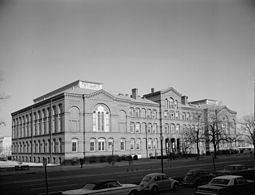
The National Mall is a landscaped park near the downtown area of Washington, D.C., the capital city of the United States. It contains and borders a number of museums of the Smithsonian Institution, art galleries, cultural institutions, and various memorials, sculptures, and statues. It is administered by the National Park Service (NPS) of the United States Department of the Interior as part of the National Mall and Memorial Parks unit of the National Park System. The park receives approximately 24 million visitors each year. Designed by Pierre L'Enfant, the "Grand Avenue" or Mall was to be a democratic and egalitarian space—unlike palace gardens, such as those at Versailles in France, that were paid for by the people but reserved for the use of a privileged few.

Tuskegee University is a private, historically black land-grant university in Tuskegee, Alabama. It was founded on July 4th in 1881 by the Alabama Legislature.
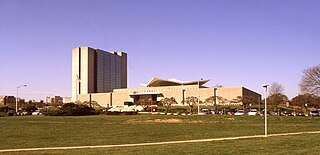
The United States National Library of Medicine (NLM), operated by the United States federal government, is the world's largest medical library.
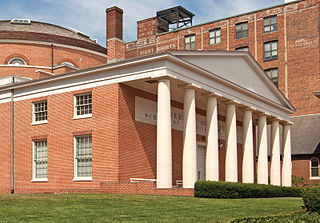
The University of Maryland, Baltimore (UMB) is a public university in Baltimore, Maryland. Founded in 1807, it comprises some of the oldest professional schools of dentistry, law, medicine, pharmacy, social work and nursing in the United States. It is the original campus of the University System of Maryland and has a strategic partnership with the University of Maryland, College Park. Located on 71 acres (0.29 km2) on the west side of downtown Baltimore, it is part of the University System of Maryland.

The Walter Reed Army Medical Center (WRAMC), officially known as Walter Reed General Hospital (WRGH) until 1951, was the U.S. Army's flagship medical center from 1909 to 2011. Located on 113 acres (46 ha) in Washington, D.C., it served more than 150,000 active and retired personnel from all branches of the United States Armed Forces. The center was named after Walter Reed, a U.S. Army physician and Major who led the team that confirmed that yellow fever is transmitted by mosquitoes rather than direct physical contact.
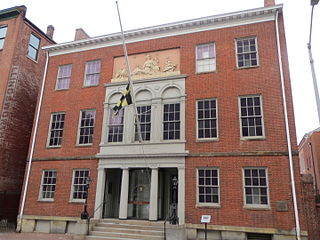
The Peale is a community museum in Baltimore, Maryland, which opened in 2022 after a 5-year renovation. It occupies the first building in the Western Hemisphere to be designed and built specifically as a museum.
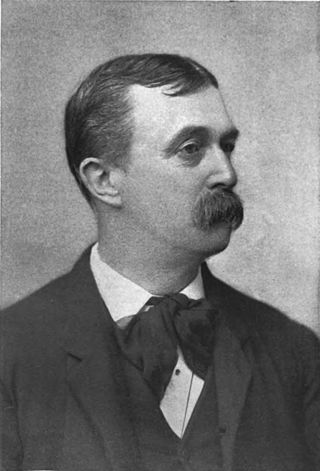
John Shaw Billings was an American librarian, building designer, and surgeon who modernized the Library of the Surgeon General's Office in the United States Army. His work with Andrew Carnegie led to the development and his service as the first director of the New York Public Library. Billings oversaw the building of the Surgeon General's Library, which was the nation's first comprehensive library for medicine.

The National Museum of Health and Medicine (NMHM) is a museum in Silver Spring, Maryland, near Washington, D.C. The museum was founded by U.S. Army Surgeon General William A. Hammond as the Army Medical Museum (AMM) in 1862; it became the NMHM in 1989 and relocated to its present site at the Army's Forest Glen Annex in 2011. An element of the Defense Health Agency (DHA), the NMHM is a member of the National Health Sciences Consortium.

Founded by U.S. Army Brigadier General George Miller Sternberg, MD in 1893, the Army Medical School (AMS) was by some reckonings the world's first school of public health and preventive medicine. The AMS ultimately became the Army Medical Center (1923), then the Walter Reed Army Institute of Research (1953).

The Library of the Surgeon General's Office, later called the Army Medical Library, was the institutional medical literature repository of the U.S. Army Surgeon General from 1836 to 1956 when it was transformed into the National Library of Medicine.
The Edward H. White II Museum of Aerospace Medicine was a museum of the United States Air Force and was located in Hangar 9 at Brooks Air Force Base, San Antonio, Texas. Brooks Air Force Base closed in 2011 under Base Realignment and Closure Commission (BRAC) procedures, and the museum closed at the same time.

The Old Naval Observatory is a historic site at 23rd and E Street in Northwest, Washington, D.C. It is where the United States Naval Observatory was located from 1844 to 1893, when it moved to its present grounds. The original observatory building, built 1839-40, still stands, and is a designated National Historic Landmark as of 1965. The Washington meridian of 1850 passes through the Observatory.

The Fort Bayard Historic District encompasses the area that was the location of Fort Bayard, a United States Army military installation north of present-day Santa Clara, New Mexico. Founded in 1866, the fort at first provided security against Native American attacks on settlers during the settlement of the region in the 19th century. It was then converted into the army's first tuberculosis sanitarium, and later became a VA hospital. The property is now the Fort Bayard Medical Center, a long-term nursing care facility operated by the state of New Mexico. The only surviving 19th-century elements of the fort are some of its landscaping, and the Fort Bayard National Cemetery. The site was designated a National Historic Landmark District in 2004.

The College of Medicine of Maryland, or also known since 1959 as Davidge Hall, is a historic domed structure in Baltimore, Maryland. It has been in continuous use for medical education since 1813, the oldest such structure in the United States. A wide pediment stands in front of a low, domed drum structure, which housed the anatomical theater. A circular chemistry hall was housed on the lower level under the anatomical theater.

The Forest Glen Annex is a 136-acre (0.55 km2) U.S. Army installation in the Forest Glen Park neighborhood of Silver Spring, Maryland, United States. It is situated between Brookville Road and Linden Lane. Since 1999, the Annex has been the site of the Walter Reed Army Institute of Research (WRAIR) and the Naval Medical Research Center (NMRC), along with smaller units.
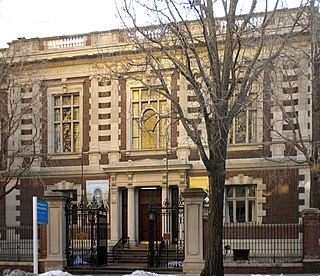
The College of Physicians of Philadelphia is the oldest private medical society in the United States. Founded in 1787 by 24 Philadelphia physicians "to advance the Science of Medicine, and thereby lessen human misery, by investigating the diseases and remedies which are peculiar to our country" and to promote "order and uniformity in the practice of Physick," it has made important contributions to medical education and research. The College hosts the Mütter Museum, a gallery of 19th-century specimens, teaching models, instruments, and photographs, as well as the Historical Medical Library, which is one of the country's oldest medical libraries.
The campus of the George Washington University (GW), originated on College Hill, a site bounded by 14th Street, Columbia Road, 15th Street and Florida Avenue, NW in the Columbia Heights neighborhood of Washington, D.C. After relocating to the downtown financial district in the 1880s and then to Foggy Bottom in 1912, GW now has three campuses. Foggy Bottom is the location of the university's main campus in Washington, D.C. Also in Washington's Foxhall neighborhood is the Mount Vernon Campus, formerly the Mount Vernon College for Women. Additionally, the George Washington University Virginia Campus is located in Ashburn, VA.

Frank Bradway Rogers was a medical doctor and librarian who was instrumental in changing the Army Medical Library into the National Library of Medicine. He helped develop an electronic system of storing and retrieving information called Medical Literature Analysis and Retrieval System (MEDLARS) which replaced the old index cataloging system. American Libraries included Rogers on the list of "100 of the most important people in 20th-century librarianship."
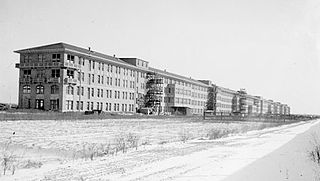
The Edward Hines Jr. Veterans Administration Hospital is a second-generation Veterans Health Administration hospital in Hines, Illinois, United States. It currently encompasses 174 acres (70 ha) on its campus and leases an additional 60 acres (24 ha) to the Loyola University Medical Center.

